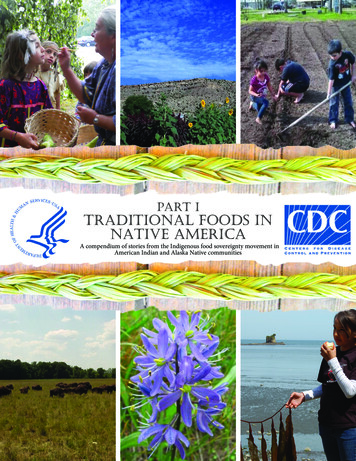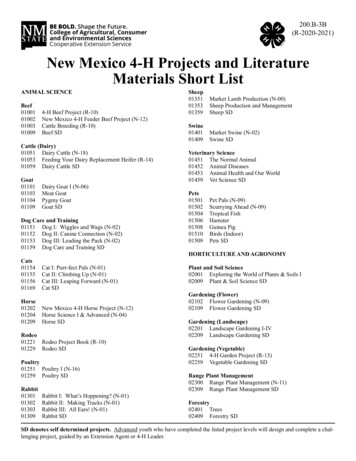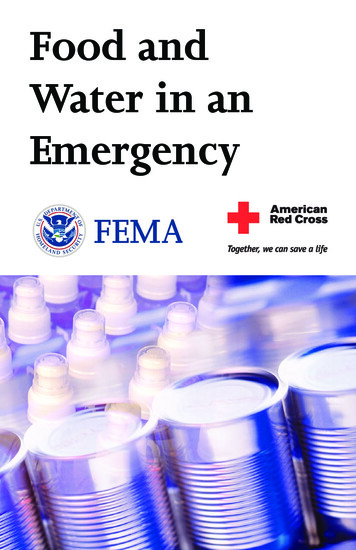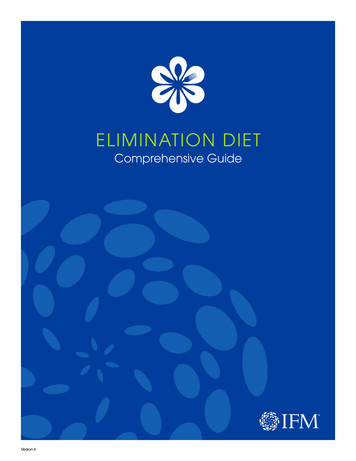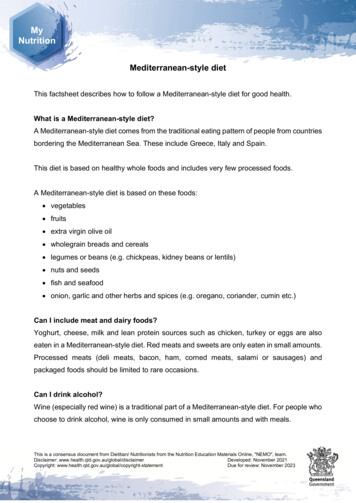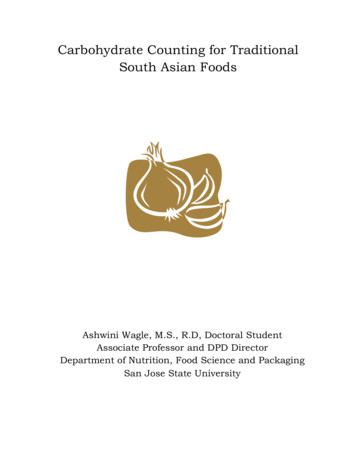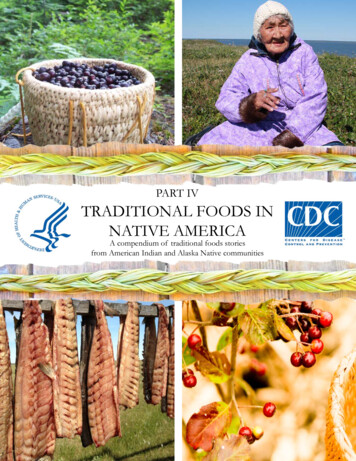
Transcription
PART IVTRADITIONAL FOODS INNATIVE AMERICAA compendium of traditional foods storiesfrom American Indian and Alaska Native communities
The land is our identity and holds for us all the answers we need to be ahealthy, vibrant, and thriving community. In our oral traditions, our creationstory, we are taught that the land that provides the foods and medicineswe need are a part of who we are. Without the elk, salmon, huckleberries,shellfish and cedar trees we are nobody. This is our medicine;remembering who we are and the lands that we come from.VALERIE SEGREST (Muckleshoot)Muckleshoot Traditional Foods and Medicines Program1
ACKNOWLEDGEMENTSThe Centers for Disease Control and Prevention’s (CDC) Native Diabetes Wellness Program expressesgratitude and thanks to Chelsea Wesner (Choctaw) of the University of Oklahoma’s AmericanIndian Institute, who collected the interviews that inspired this report. Ms. Wesner wrote this report incollaboration with the Native Diabetes Wellness Program (NDWP).Collaborators and the author would especially like to thank staff and tribal members from the programsand organizations featured: Ahchâôk. Ômâôk. Keepunumuk. (Hunt. Fish. Gather.), Washington Universityin St. Louis; Eagle Adventure, Chickasaw Nation Nutrition Services and Oklahoma State University; Fishto-School, Center for Alaska Native Health Research at the University of Alaska Fairbanks; IndigenousFood and Agriculture Initiative, University of Arkansas School of Law; Muckleshoot Traditional Foodsand Medicines Program, Muckleshoot Indian Tribe in Auburn, Washington; NATIVE HEALTHCommunity Garden in Phoenix, Arizona; Niqipiaq Challenge, North Slope Borough Health Departmentin Barrow, Alaska; Store Outside Your Door, Alaska Native Tribal Health Consortium (ANTHC) inAnchorage, Alaska; and Tribal Historic Preservation Department, Sherwood Valley Band of Pomo Indiansin Willits, California. This report would not have been possible without the sharing of their stories anddiverse experience in restoring traditional food systems.The findings and conclusions in this report are those of the author, Chelsea Wesner, and collaboratorsfrom the NDWP and do not necessarily represent the official position of CDC.Suggested citation: Centers for Disease Control and Prevention (2015). Traditional Foods in NativeAmerica—Part IV: A Compendium of Stories from the Indigenous Food Sovereignty Movement inAmerican Indian and Alaska Native Communities. Atlanta, GA: Native Diabetes Wellness Program,Centers for Disease Control and Prevention.2
TABLE OF CONTENTSIntroductionand SharedThemesPart I: TribalCommunitiesand Inter-tribalOrganizationsPart II:Spotlight onAlaska NativeTraditionalFoodsInitiativesPart III:TribalUniversityPartnershipsAppendices4Purpose and Background4Methods6Significance of Homelands in Building Food Sovereignty in Indian Country7Key Findings and Shared Themes10Muckleshoot Traditional Foods and Medicines Program, MuckleshootIndian Tribe —Washington16NATIVE HEALTH Community Garden—Arizona23Tribal Historic Preservation Department, Sherwood Valley Band of PomoIndians—California31Fish-to-School, Center for Alaska Native Health Research at the Universityof Alaska Fairbanks—Alaska37The Niqipiaq Challenge, North Slope Borough Health Department—Alaska41Store Outside Your Door, Alaska Native Tribal Health Consortium—Alaska48Ahchâôk. Ômâôk. Keepunumuk. (Hunt. Fish. Gather.), WashingtonUniversity in St. Louis —Missouri61Eagle Adventure, Chickasaw Nation Nutrition Services Get Fresh!Program and Oklahoma State University—Oklahoma68Indigenous Food and Agriculture Initiative, University of Arkansas Schoolof Law—Arkansas74Contact Information75Additional Resources76References3
PURPOSE AND BACKGROUNDCommissioned by the Centers for Disease Control and Prevention’s (CDC) Native Diabetes WellnessProgram (NDWP), this report is the fourth in a compendium of stories highlighting traditionalfoods programs in culturally and geographically diverse American Indian and Alaska Native (AI/AN)communities. The compendium, Traditional Foods in Native America, can be accessed at nal-foods.htm.As noted in parts I through III of the compendium, through cooperative agreements with 17 tribalgrantee partners between 2008 and 2014, the NDWP’s Traditional Foods Program helped leverage humanand natural resources to promote sustainability, traditional foodways, and improve health. The partnergrantees represent tribes and tribal organizations from coast to coast, each taking a unique approach torestoring and sustaining a healthful and traditional food system. While supporting health promotion andtype 2 diabetes prevention efforts, these projects also addressed critical issues such as food security, foodsovereignty, cultural preservation, and environmental sustainability.Part I of the compendium features six traditional foods programs and initiatives, part II highlights six ofNDWP’s Traditional Foods Program partner grantees, and part III includes nine stories, a combination ofpartner grantees and traditional foods initiatives independent of NDWP. As the collection of stories hasevolved, shared themes have emerged from building capacity for food security in parts I and II to the roleof storytelling in preserving cultural knowledge and foodways in part III. Inspired by previous editionsof the compendium, the nine stories presented here comprise part IV in the series with the central themeof reclaiming and preserving ancestral homelands to support subsistence traditions and strenghten Nativefoodways.To collect this compendium of stories and interviews, NDWP partnered with Chelsea Wesner, a memberof the Choctaw Nation of Oklahoma, with the American Indian Institute at the University of Oklahoma.Based on interviews with key people in each community, the stories in this compendium demonstrate howtraditional foods programs are building food security, preserving cultural knowledge, and restoring health.MethodsThis compendium used ethnographic methods in order to understand the cultural significance andbenefits of traditional foods programs in Native American communities. These methods guided thecollection of stories through informal and structured interviews and helped identify the common themesamong them. Following an informal conversation, each interviewee was asked to respond in writing to fiveor six open-ended questions. This method gave the storyteller time to think about what she or he wouldlike to say, allowing a rich and thoughtful narrative process.Nine traditional foods programs and supporting organizations were invited to participate for this report.These nine programs were identified by the author and NDWP staff as having innovative approaches to4
encouraging traditional foods promotion and promising practices.The interviews and stories for the entire compendium were collected from the AI/AN nations and tribalorganizations outlined in the table below. The nine programs and supporting organizations featured in thisreport are listed under part IV.Table 1. Programs featured in compendium.TRADITIONAL FOODS IN NATIVE AMERICAA Compendium of Stories from the Indigenous Food Sovereignty Movement inAmerican Indian and Alaska Native CommunitiesPART IPART IIPART IIIPART IV*Mohegan Foodways(Mohegan Tribe)*Mvskoke FoodSovereignty Initiative(Muscogee (Creek) Nation)*Oneida CommunityIntegrated Food Systems(Oneida Nation)*Seven Arrows Garden(Pueblo of Laguna)*Suquamish CommunityHealth Program(Suquamish Tribe)*Traditional Plants andFood Program(Northwest Indian College) Ramah Navajo Community Standing Rock Sioux Tribe Aleutian Pribilof IslandsAssociation, Inc. Tohono O’odham Nation*First NationsDevelopment Institute (FNDI)* Aleutian Pribilof IslandsAssociation, Inc.*NATIVE HEALTH(Phoenix, AZ)* Cherokee Nation ofOklahoma*Ahchâôk. Ômâôk.Keepunumuk. (Hunt. Fish.Gather.) (Washington University in St. Louis)*Sherwood Valley Pomo Tribe*Eagle Adventure ProgramChickasaw Nation SNAP and Southeast Alaska RegionalSNAP ED ProgramsHealth Consortium (SEARHC) (Chickasaw Nation)* Southeast Alaska Regional Healthy Roots (Eastern BandHealth Consortium (SEARHC) of Cherokee Indians) Building Community—Strengthening Traditional Ties(Indian Health Care ResourceCenter of Tulsa)*Food is Our Medicine(Seneca Nation)*Fish-to-School—Center forAlaska Native Health Research(University of AlaskaFairbanks)*Indigenous Food andAgriculture Initiative (Universityof Arkansas School of Law) Community Health Program(Salish Kootenai College) Healthy Traditions Project(Confederated Tribesof Siletz Indians) Indicates Traditional Foods Program grantee partners, a program under CDC’s Native Diabetes Wellness Program.*Indicates other food sovereignty communities and programs in Indian country.5
Significance of Homelands in BuildingFood Sovereignty in Indian CountryAprimary tenet of the global food sovereignty movement asserts that food is a human right, andto secure this right, people should have the ability to define their own food systems.1 In recentdecades, an increasing number of AI/AN nations have become a part of this global movement byreclaiming traditional food systems and practices. Throughout this compendium, we are learning how tribalcommunities are benefiting from this decision. However, for tribal communities with limited access to theirhomelands, food sovereignty remains only a phrase rather than a reality.The history of ancestral homelands and water rights in Indian country is marked with disruption.2Of relevance to the field of public health, access to homelands is a social determinant of health thathas received little consideration for many indigenous peoples, especially among AI/AN communitiespracticing subsistence traditions.2,3 While the social determinants of health are primarily considered thecircumstances in which people are born, live, work, and play, AI/AN peoples have a special relationshipwith land reaching far beyond a place to live. Stories featured in this report highlight this relationship,illustrated by this quote that beautifully describes the deep connection between land and indigenouspeoples:The land is our identity and holds for us all the answers we need to be a healthy, vibrant, andthriving community. In our oral traditions, our creation story, we are taught that the land thatprovides the foods and medicines we need are a part of who we are. Without the elk, salmon,huckleberries, shellfish and cedar trees we are nobody. This is our medicine; remembering whowe are and the lands that we come from.Valerie Segrest (Muckleshoot)Muckleshoot Traditional Foods and Medicines ProgramTo honor and preserve this relationship with the land, Janie Simms Hipp, director of the Indigenous Foodand Agriculture Initiative at the University of Arkansas School of Law, recommends a systems approach,calling for AI/AN tribes to begin building—through tribal self-governance—sound infrastructure thatsupports food sovereignty:The sustainability and long-term stability of Indian Country’s food and agriculture systems needstribal governance built into those systems in order to ensure our foods are protected, not overlyregulated, and allowed to thrive and become more resilient.Janie Simms Hipp, JD, LLM (Chickasaw)Indigenous Food and Agriculture Initiative1“Global Small-Scale Farmers’ Movement Developing New Trade Regimes”, Food First News & Views, Volume 28, Number 97Spring/Summer 2005, p. 2.2Satterfield, D., DeBruyn, L., Francis, C., & Allen, A. (2014). A Stream Is Always Giving Life: Communities Reclaim Native Scienceand Traditional Ways to Prevent Diabetes and Promote Health. American Indian Culture and Research Journal, 38(1), 157-190.3Liburd, L. C. (2009). Diabetes and health disparities: Community-based approaches for racial and ethnic populations. SpringerPublishing Company, p. 5.6
Accounts of the importance of land in building food security, food sovereignty, economic development,cultural knowledge, and well-being are woven throughout the stories in this compendium. Shared themesunderscore the significance of land to indigenous peoples and illuminate the renaissance of NativeAmerican foodways.Key Findings and Shared ThemesIn this report, key findings and shared themes reveal that traditional foods programs in Native Americancommunities hold a number of common beliefs and practices to support the process of reclaiming atraditional food system. The significance of land is woven throughout the majority of the themes and islisted first. Many of the phrases included under the Significance of land theme are found in subsequentthemes. Derived from the programs featured here, the following themes are listed in order from the mostshared beliefs and practices to those more culturally and geographically unique.1. Significance of land: Recognition of the importance of protecting and reclaiming ancestral lands;strengthening tribal self-governance in order to leverage natural resources on tribal lands; concernswith regulations and access to traditional homelands for subsistence fishing, gathering, and hunting;significance of land (reclamation of historical sites for traditional foods initiatives); and concerns withthe impact of the oil and gas industry on Alaska Native ancestral lands and water. Subsistence traditions and sustainably sourced food: Eating seasonally; leveraging and strengthening tribalself-governance to revive local food and traditional food systems; preserving subsistence practicesand traditions; sustainability of Native foodways and homelands; professional developmentopportunities for Native youth interested in food and agriculture; seminars and workshops oncooking, hunting, gathering, fishing, and preserving; and environmental stewardship.Interest in Native American food pathways and foodsheds: Following the flow of the production andconsumption of local, traditional foods; participating in decision-making and policies that influencefoodsheds on or near tribal lands; web-based videos highlighting traditional foods practices andfoodways; and the renaissance of Native foodways and Native American cuisine.Fostering intergenerational relationships: Learning traditional subsistence practices from tribalelders; engagement of children as educators; sharing health messages with their families; andintergenerational interactions as strengthening traditional ecological knowledge and socialconnections.2. Community engagement: Community- and campus-wide traditional food dinners; cookingdemonstrations using traditional foods; Iron Chef-style cooking competitions; strategic business andcommunity planning technical assistance; youth professional development opportunities; symposiums,trainings, and seminars; traditional food-themed scavenger hunts; and food/film festivals.3. Community-driven planning: Conducting community needs assessments and formative research;community-based approach in program development; employing a community-based participatoryresearch (CBPR) approach to guide programs; engaging tribal stakeholders to help identify traditionalfoods experts; and creating a community advisory council to guide and inform program development.7
4. Sharing of traditional foods recipes and cooking/preparing demonstrations: Hands-on fooddemonstrations and taste tests for children; web-based videos highlighting traditional foods practicesand foodways; and cooking demonstrations and contests using traditional foods in combination withschool cafeteria staples and commodity foods available through the US Department of Agriculture’s(USDA) Food Distribution Program on Indian Reservations (FDPIR).5. Emphasis on education: Developing lesson plans and curricula on traditional foods and Nativefoodways; providing education to raise awareness of traditional foods and health; professionaldevelopment opportunities for Native youth interested in food and agriculture; seminars andworkshops on cooking, hunting, gathering, fishing, and preserving; and educating tribal membersand interested parties (e.g., state and local government officials) on Native food sovereignty and localtraditional foods.6. Elder involvement: Engaging tribal elders as advisors to guide and inform program development;and supporting the role of elders as teachers of traditional knowledge and practices related to Nativefoodways.7. Funding sources and community partners: Traditional foods programs supported through grantsand contracts with governmental agencies [USDA’s FDPIR, Supplemental Nutrition AssistanceProgram Education (SNAP-Ed), National Institute of Agriculture (NIFA), and Indian Health Service’sUrban Indian Health Program]; university partnership and support (Washington University in St. Louis,University of Arkansas, University of Alaska Fairbanks, Oklahoma State University, and more); stateand county health departments; tribal partner and tribal member support; and other organizations (FirstNations Development Institute, Community Alliance for Global Justice, Center for World IndigenousStudies, and Institute for Agriculture and Food Trade).8. Well-being: Collective consensus that traditional foods and practices are an alternative approach towell-being and health.Featured InterviewsThe following section includes interviews and stories from nine traditional foods programs andinitiatives. Three tribal communities and inter-tribal organizations are highlighted: the MuckleshootTraditional Foods and Medicines Program of the Muckleshoot Indian Tribe in western Washington;NATIVE HEALTH Urban Garden, serving urban American Indians in the city of Phoenix metropolitanarea; and the Sherwood Valley Band of Pomo Indians in northern California through an interview with theTribal Historic Preservation Officer.Following the tribal community stories, a spotlight on Alaska Native traditional foods initiatives featuresthree programs: Fish-to-School, a project led by the Center for Alaska Native Health Research at theUniversity of Alaska Fairbanks; the Niqipiaq Challenge, a traditional foods challenge organized by theNorth Slope Borough Health Department in Barrow, Alaska; and “Store Outside Your Door,” a creative8
webisode series produced by the Alaska Native Tribal Health Consortium in Anchorage, Alaska.The final three stories highlight traditional foods initiatives developed through tribal-universitypartnerships: Ahchâôk. Ômâôk. Keepunumuk. (Hunt. Fish. Gather.) at Washington University in St. Louis;Eagle Adventure, a children’s program led by a partnership between Chickasaw Nation Nutrition Servicesand Oklahoma State University; and the Indigenous Food and Agriculture Initiative at the University ofArkansas School of Law.PART I:Tribal Communities and Inter-Tribal OrganizationsMuckleshoot Traditional Foods and Medicines ProgramMuckleshoot Indian Tribe —WashingtonNATIVE HEALTH Community GardenArizonaTribal Historic Preservation DepartmentSherwood Valley Band of Pomo Indians—California9
10
MUCKLESHOOT INDIAN TRIBEMuckleshoot Traditional Foodsand Medicines ProgramWashingtonThe following is an interview with Valerie Segrest, director of the Muckleshoot Traditional Foods andMedicines Program. The Muckleshoot Indian Tribe is located in western Washington in the CentralPuget Sound region. This interview highlights the renaissance of traditional foodways and ancestralhomelands of the Muckleshoot Indian Tribe and surrounding areas. Valerie is an acclaimed Native foodsovereignty advocate, community nutritionist, and Muckleshoot tribal member.Q: Tell us how the Muckleshoot Traditional Foods and Medicines Program is helping revitalizethe Northwest Coastal Indian food culture.A: We really try to take a strategic and active approach. Strategy sessions include getting the pulse of thecommunity, holding listening groups and checking in with our tribal leaders on challenges we face. Thenwe follow up with some sort of action—planting a garden, harvesting excursions, identifying knowledgekeepers, holding food education workshops, and sharing our story. In this process people become less foodconsumers and more active citizens. Ultimately, traditional community democratic processes are upheld,and we use our traditional foods as the organizing tool. This makes sense as our cultural teachings outlinethe inherent wisdom of our foods. We see that while we face many challenges in obtaining a diet thatupheld our ancestors’ health since time immemorial, we also see opportunities for healing to happen.Q: Describe the significance of the land on which your tribal members fish, hunt, and gathertraditional foods and medicines. What are some of the traditional foods and medicines specific toyour region?A: The land is our identity and holds for us all the answers we need to be a healthy, vibrant, and thrivingcommunity. In our oral traditions, our creation story, we are taught that the land that provides the foodsand medicines we need are a part of who we are. Without the elk, salmon, huckleberries, shellfish andcedar trees we are nobody. I witness this time and time again, when people get out on the land—actively inpursuit of wild game, fishing the rivers and sea, harvesting foods and medicines with good intention—weare gifted with new memories and those of a distant past. These memories help ground us in a place thatpromotes a sense of generosity and balance. This is our medicine; remembering who we are and the landsthat we come from.The Muckleshoot Tribe has taken on several initiatives historically and presently in order to demonstratehow much of a priority our lands are. Last year the tribe led an initiative to organize the entire IndianCountry in standing against the development of a genetically engineered salmon species. The year beforethat the Muckleshoot Indian Tribe made the decision to purchase nearly 100,000 acres of forest lands—our ancestral lands—from Weyerhauser. This year the tribe brought me on as manager of the Traditional11
Photos on this page and page 10 are courtesy of Valerie Segrest.Foods and Medicines Program to bring our community organizing efforts in house. All of this was donewith the wonderful vision and leadership of our Tribal Council. This kind of forward thinking is necessaryin order for our nations to demonstrate how much the land means to us and what a priority it truly is.Q: Describe your approach to engaging tribal members in traditional foods activities.A: We take a community-based approach to our activities. The agenda is developed based on communityinput, the presenters invited are our own gifted teachers, and we invite elders to witness our work andprovide feedback on how we can make each gathering and initiative better. With every direction we headtowards, the community is a sounding board. We believe that we have everything we need to overcomechallenges and revitalize our culture right here among us. This means we have to stop talking about ourculture as if it were in the past and shift our vocabulary to the present. For example, use present languagesuch as “we harvest nettle to make cordage. Our families gather berries together. Each year we fish therivers and harvest clams, mussels, and oysters to share amongst our village,” rather than past vocabularysuch as “we used to, but not anymore.” We believe that talking about our culture in the past promotes the“museum mentality” that we are a noble people of a distant past. This also perpetuates the thinking thatour traditional ecological knowledge is lost or outdated. We have always been innovative people, and westill are today.12
Valerie Segrest (Muckleshoot) leading traditional foods workshops. Photos courtesy of Valerie Segrest.The success of this program is due to prioritizing our culture, meeting people where they are at, and liftingpeople up.Q: You’ve played a leading role as an advocate and educator of traditional foods and medicines.Share with us your vision for Native American foodways in the next decade.A: I envision more Native people empowering themselves through empowering the land. I envision afuture where community gardens and farmers and ranchers are not the only priority in the good foodrevolution—ancient berry meadows, fishermen, and hunting will also be discussed. I envision more Nativepeople sitting at the tables where decisions about our foodsheds are being made and feeling that they arejust as entitled to be there as everyone else. I envision my daughters fishing salmon in their ancestral riversand harvesting in their forest gardens. We are resilient people who are living in a time of opportunity, andso is the land we originate from. I believe this is realistic.13
14
Photos on current and previous page courtesy of Valerie Segrest.Q: What are some of the key partnerships you’ve established to help support and sustain thisproject?A: The first partnership and utmost priority is with the community itself. Rather than build a new program,we sat down with several community members and identified all of our available resources, how theycould work better with one another, and how to make it better from there. Our tribal leadership is alwaysinformed of everything we do. They advocate for our needs and they themselves are keepers of foodknowledge. We work with the county, state, and federal government on several things as well as severalhigher learning institutions. Important allies like the First Nations Development Institute, CommunityAlliance for Global Justice, Center for World Indigenous Studies, and the Institute for Agriculture andFood Trade Policy have also been key to our community’s traditional food renaissance.Special thanks to Valerie Segrest for sharing her time and stories. To learn more about this project, pleasefind contact information on page 74.15
Working at the Community Garden site. Photos on this page and next courtesy of NATIVE HEALTH.NATIVE HEALTHCommunity GardenArizonaThe following is an interview with NATIVE HEALTH’s Evelina Maho, director of the HealthPromotion/Disease Prevention Program. Founded in 1978, NATIVE HEALTH is located inPhoenix, Arizona, and was formerly known as the Native American Community Health Center, Inc.NATIVE HEALTH provides a range of patient-centered and culturally sensitive health care includingprimary, pediatric, prenatal, women’s health, podiatry, optometry, diabetes and chronic care management,and integrated behavioral health. This interview highlights the clinic’s Urban Garden, which wasestablished in 2014 on the former site of the historical Phoenix Indian School. NATIVE HEALTH is awonderful example of incorporating traditional foods and cultural knowledge in relation to health withurban American Indian families and individuals.Q: Tell us a bit about the founding of and vision for the NATIVE HEALTH Community Garden.A: The NATIVE HEALTH Community Garden creates an opportunity to increase accessibility of healthyfoods among urban American Indians in Phoenix, AZ, with the purpose of retaining cultural knowledge16
17
Photos courtesy of NATIVE HEALTH. Next page: Map of NATIVE HEALTH Community Garden and Walking Trails.and an understanding of food and cultural ties through integrated and interactive approaches. Thecommunity garden utilizes local and regional cultural experts to educate, empower, and build capacity togrow and produce healthier foods. From the garden and walking path—with the opportunity of leveragingthe community to embrace sustainable food access—and cultural knowledge to rekindle the spirit ofkinship; to land, air, water and sun, elements essential in planting and harvesting food, essential for life.In 2014, the Community Garden project began its work with community members, elders, and culturalspecialists to bring a culturally sensitive public health approach, which integrates southwest AmericanIndian practices and customs related to food, plants, crops and herbs. The existing garden program offersmonthly workshops, seminars, and storytelling sessions to provide urban American Indians differentcultural perspectives to food and plants. The garden provides opportunity to reconnect kinship to land,air, water, and sun. The garden currently has thirty-three raised beds adopted by families and communitymembers with each gardener responsible for the preparation of soil, planting, maintaining, and harvestingtheir adopted raised bed.Q: Describe the significance of the land on which the garden resides. How has the land beentransformed into a space for urban gardening and health promotion?A: In November of 2013, the City of Phoenix and non-profit organization Keep Phoenix Beautifulapproached NATIVE HEALTH to participate in the PHX Renews project. The city established KeepPhoenix Beautiful to identify vacant urban lots scattered across Phoenix and convert them into safe green18
RAISED GARDEN BEDS (33)125689341831STONE BENCH (2)WATER TOWER (2)716192620LARGE RAISED GARDEN BEDS RINTHNEWGRAVEL PATHS(not to scale)REVISED 03/2015EDUCATION BOOTH (2)STRETCHINGSTATION (4)PICNIC TABLE &SHADE STRUCTURESTONE BENCH (2)19
Photos courtesy of NATIVE HEALTH.bio-friendly environments. The land identified, and which this project is centered on, is 15 acres of parcelat the intersection of Indian School Road and Central Avenue in Phoenix. This property is privately ownedand has been vacant for more than twenty years. Keep Phoenix Beautiful, PHX Renews, and NATIVEHEALTH began their collaboration to establish the NATIVE HEALTH Community Garden in Januaryof 2014. The Community Garden resides on what was formerly known as the Phoenix Indian Schoolfrom the late 1890s through 1987. The Indian School provided education to students from more than 30different tribes from different parts of the country (US Department of Interior) during that period.NATIVE HEALTH Community Garden is an active garden which resides on 1.5 acres of the designatedsite’s 15 acres. In addition to the monthly events, gardeners have
American Indian Culture and Research Journal, 38(1), 157-190. 3 Liburd, L. C. (2009). Diabetes and health disparities: Comm


